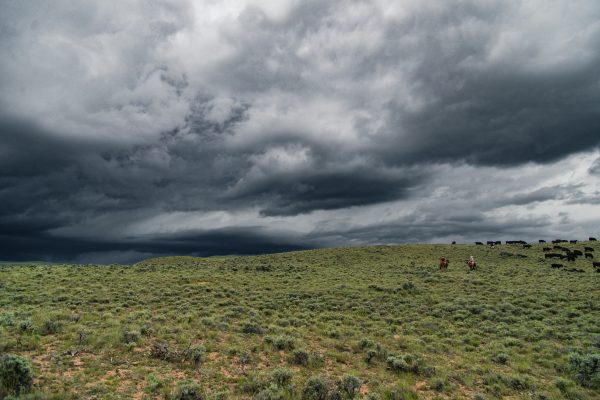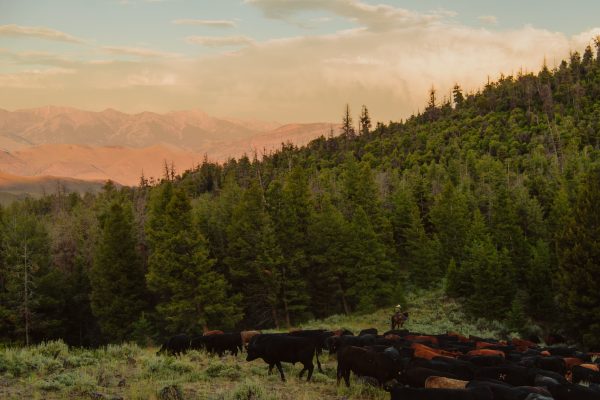
It freezes nearly every night now on the ranch, and it means being outside before sunup can be a little bracing. It’s time to dig around under the front seat of the pickup and find out where that ice scraper went, as vehicle windows are often crusted with ice in the early morning. So much for the garden. Black zucchini leaves don’t do photosynthesis real well.
That doesn’t mean that it doesn’t warm up. Josh and I were up on the high ranges horseback most of yesterday afternoon, and it was a balmy 80 degrees. Our steeds even broke a bead of sweat while we rode across the broken hills. But the heat was short lived, and soon found us finding more clothes as the sun went down: Josh with a light jacket, and me with my silk scarf, because if my neck is warm, I am warm.
The range was quiet and windless. We jumped an antelope buck high up on Bear Basin, and a foraging coyote on the way out. I thought we’d run across a herd of elk or bear looking for grub before winter, but no such luck.
We rode for three reasons. The first was to continue to look for our lone missing steer. To that end, we covered much of the same country we trailed through over the summer thinking that he may have returned to some of his familiar haunts. I don’t rest until we find him. Only with the deep snows of winter will we resort to the hopelessness of his demise by the likely predation by a wolf pack.
The second reason for the ride was to plan our fall grazing tour. Next week, some 25 riders will saddle up with us to see how things went with the 24/7 grazing project. For those of you who don’t remember, it entailed living with the beeves for the entire summer, the way herders have done since the beginning of cows and people living in concert—indeed, likely the “oldest profession.”
The signature on the landscape of this new concept is undeniable, as beeves, when left to their own devices will behave badly, trashing habitat for the other animals, plants and fish we share these wild landscapes with. When herded 24/7 like we have this summer, none of this “habitat trashing” occurred. We could control use perfectly”¦and while doing that actually enhance the health and performance of our beeves.
Some of the ranchers from Central Idaho Rangelands Network and folks from environmental organizations like The Nature Conservancy and Trout Unlimited will ride with us, as they are interested in the concept and are looking forward to results. Reps from the BLM and Forest Service will ride too. They are uncertain about the idea, but are interested.
The third reason was to see if there was anyone stealing our grass. The saying “good fences make good neighbors” rings true, but it is a little difficult for us (and our neighbors) to keep up with all of our fence when we have over 50 miles of it to take care of.
Creeping snow drifts and hundreds of elk take their toll on our fence lines in the off season, and it is many days on horseback packing tools and wire to keep it all standing. We left a lot of grass for wildlife and streambank stability this year, and want it to stay that way. We’re trying to grow healthy stands of aspen and willow back in areas that had them historically, both for animal hiding cover, and soil stability.We first headed up the rock strewn wash we call Pig Creek Canyon, not unlike a frying pan at the peak of sun height on a September afternoon. Pigs could probably thrive in there, but not humans”¦or horses”¦it was hot. I have no idea why “Pig Creek;” we were only some 300 plus miles from the nearest hog operations down in the plains of southern Idaho.
Pig Creek’s dissected upper reaches moderated from canyon to the open and rolling hills of Bear Basin—a high mountain desert version of the Kansas prairie. Though cured from the dry season typical of the mid elevation Rockies, the hills were cloaked with the golden of unbroken grass. In June, when Alderspring’s beeves and riders lived and trailed through the Basin’s 6 square miles, the grass waved in the wind, a sea of green punctuated by mountain wildflowers and rock outcrops that betrayed the rich volcanic roots of the soils on which they thrived. In June, beeves gained legendary weight on the wild wellness of those grasses, as did a century of cattle and sheep before them”¦and bison before them.
I’ve been on horseback in this country for 11 years now, and each time initiates a new interpretation of a landform or vegetation pattern that I never processed before. This time, it was as we went over a mountain pass, the only easy way to get into the upper basin of Little Hat Creek and Texarkana. The trail was pasted to a steep side hill. One misstep by your mount could easily send horse (and you!) tumbling to their death to the canyon far below. But these were mountain horses, and could be trusted. Our mantra is “trust the horse”¦or get off”.
The fascinating thing about this trail is that there are nearly 20 parallel trails cut into the mountainside in this spot, right next to each other. Naturalists call these things terrasets. So if you were on foot, you could actually jump down a stairstep pattern down the slope in the amount of 20 or so huge stairsteps.
These were no wimpy game trails formed by eons of deer and antelope use. These were well excavated, solid trails across the hill up to 3 feet wide. Bison? Perhaps, but there just wasn’t enough open prairie country beyond this pass to coax large herds upward. Sure, occasional bands wandered up here as evidence by the occasional buffalo skull found up here in ancient wallows, but it didn’t add up.
A recalled conversation I had 10 years earlier with a nearby older rancher solved the puzzle. He spoke of the “Beef Trail” that came off our grazing range. It was a conduit of cattle that cowboys used when trailing large herds of cattle off the unfenced and common free grazing summer ranges in the late 1800s through the 1930s.
I called him just this morning to solve the mystery. I reminded him of the Beef Trail, and asked him exactly where it went. Indeed, it traveled through exactly the area of the terresets. He said after they gathered all of the high country they likely trailed around 5400 head through that narrow gap every September. A half a century of that level of bovine travelers could certainly etch a signature into the landscape!
This was before the advent of feedlots. Half of those cattle were yearlings, and were separated off and long-trailed 150 miles to waiting trains at the railhead in Mackay, Idaho. The next solid ground those beeves walked on was at the Chicago stockyards, where “The Jungle” of mega meatpacking took over, made infamous by writer Upton Sinclair, who exposed the industry for unhealthy packing practices, and bitterly subhuman working conditions.
In spite of the poor practice of packing in those days, beef was better in flavor and nutrition than it is now. It was because it was founded only on wild grasses that came off wild prairies and ranges like ours. Corn feeding was largely non-existent. Is there evidence that it was better? Certainly: read on.
The time is now 2007, and the place is the Capital City Farmer’s Market, in Boise, Idaho. It’s a lovely, cool Saturday morning, and I have my Alderspring booth set up, and cubed chunks of chuck roast for sampling are simmering in their own juices in a pot on the camp stove next to the till. A gray-haired, wrinkled and slow moving gentleman stops on his wandering through the market space on 8th Street as the crowd flows around him. He is a rock, jutting up in the current of a river.
He doesn’t know what anchors him to the spot”¦a memory perhaps? I see him, and we lock eyes. He comes over, hoping I can help him.
“What do I smell?” he asks.
I smile. I have been to this place many times before. “It’s my chuck roast chunks. From the beef I raise. Would you like some?”
It’s his turn to smile. And he quietly picks up a toothpick while I hold the lid open for him.
“Can I have two?”
I nod. He lets the beef chunks linger beneath his nose before he opens his mouth, and slowly places them on his tongue. And savors, chewing with his eyes closed.When he looks at me again, his reverie ends, and says “this is”¦ beef. I remember now. I have not had this since I was a child in my mother’s kitchen.”
Enough said. We are excited about how so many pieces are coming together for us: the flavor, the wild landscapes, the recovery of herding skills, the restoration of the wildlands we manage. We keep going backward in time, recovering old skills that should have never been abandoned and finding they work for what ails us, both in our own health as well as the health of the land.
Thanks for coming on the ride with us! Without you, we could not do this.







Leave a Reply